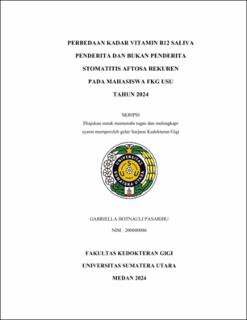| dc.contributor.advisor | Astari, Pocut | |
| dc.contributor.author | Pasaribu, Gabriella Hotnauli | |
| dc.date.accessioned | 2024-09-24T08:41:56Z | |
| dc.date.available | 2024-09-24T08:41:56Z | |
| dc.date.issued | 2024 | |
| dc.identifier.uri | https://repositori.usu.ac.id/handle/123456789/97618 | |
| dc.description.abstract | Recurrent Aphthous Stomatitis (RAS) is an oral disease which its predisposing factors are multifactorial. One of the factors is nutritional deficiency. Vitamin B12 deficiency has been known to be associated with RAS occurrence. The purpose of this research is to determine the difference of salivary vitamin B12 levels in RAS patients and non-RAS patients among academic and clinical dental students at the Faculty of Dentistry, Universitas Sumatera Utara. This study is an observational analytical research with a case-control design involving 58 samples, consisting of 29 case groups (RAS patients) and 29 control groups (non-RAS patients), gender and age matching of the control groups were conducted according to inclusion criteria, not consuming vitamin B12 supplements in the last month before sample collection, absence of systemic diseases or current medication history, non-pregnant status, and willingness to participate in the study with informed consent, and exclusions included non-cooperative behavior, use of orthodontic wires, and removable prosthetic teeth. Sample selection was done using purposive sampling technique. Saliva samples were collected unstimulated using the drooling method. Salivary vitamin B12 levels were measured using the ELISA method. Statistical data processing and analysis were conducted using Independent t-test. The research results showed that salivary vitamin B12 levels were higher in males (499.2346 ± 102.2857 pg/mL) compared to females (408.8281 ± 140.4884 pg/mL), and that RAS patients had higher salivary vitamin B12 levels (448.4066 ± 140.1430 pg/mL) compared to non-RAS patients (425.3640 ± 145.5563 pg/mL), with no significant difference in the mean of salivary vitamin B12 levels between the case and control groups (p = 0.542). The conclusion of this study was that there was no significant difference in salivary vitamin B12 levels between RAS patients and non-RAS patients among dental students at Faculty of Dentistry, Universitas Sumatera Utara. | en_US |
| dc.language.iso | id | en_US |
| dc.publisher | Universitas Sumatera Utara | en_US |
| dc.subject | Recurrent aphthous stomatitis | en_US |
| dc.subject | nutritional deficiency | en_US |
| dc.subject | vitamin B12 | en_US |
| dc.subject | SDGs | en_US |
| dc.title | Perbedaan Kadar Vitamin B12 Saliva Penderita Stomatitis Aftosa Rekuren pada Mahasiswa FKG USU Tahun 2024 | en_US |
| dc.title.alternative | The Difference of Salivary Vitamin B12 Levels in RAS Patients and Non-RAS Patients Among Dental Students at Faculty of Dentistry Universitas Sumatera Utara in 2024 | en_US |
| dc.type | Thesis | en_US |
| dc.identifier.nim | NIM200600086 | |
| dc.identifier.nidn | NIDN0003038901 | |
| dc.identifier.kodeprodi | KODEPRODI12201#Pendidikan Dokter Gigi | |
| dc.description.pages | 85 Pages | en_US |
| dc.description.type | Skripsi Sarjana | en_US |


